Abstract
BACKGROUND: Strongyloides stercoralis can cause a wide spectrum of disease in man, ranging from a chronic asymptomatic infection to a hyperinfective, often fatal syndrome. In rodents, spontaneous expulsion of Strongyloides spp occurs after experimental infection. Mast cells, goblet cells, and eosinophils have been identified as possible effectors of this expulsion. AIMS: To investigate intestinal histopathology and mucosal immunity in immunocompetent patients with chronic S stercoralis infection. METHODS: Jejunal biopsies were performed in 19 immunocompetent patients with a positive stool examination for S stercoralis and few or no symptoms, and in seven healthy controls. Specimens were processed for histopathological analysis and stained by the immunoperoxidase technique, using the following monoclonal antibodies: CD2, CD3, CD4, CD8, anti-T cell receptor (TcR) gamma/delta, RFD1 and RFD7 (two different macrophage markers), Ki67+ (proliferating) cells, antihuman leucocyte antigen (HLA)-DR, and anticollagen IV. In addition, CD25+ cells, mast cells, IgE expressing cells, calprotectin containing cells, and neutrophil elastase positive cells were stained by the alkaline phosphatase method. RESULTS: Jejunal morphology and the numbers of different T cell subsets, mast cells, IgE expressing cells, eosinophils, and goblet cells were unaffected by S stercoralis infection. Conversely, the numbers of mature macrophages and dividing enterocytes in the crypts were reduced significantly. Crypt enterocytes did not express HLA-DR in both groups. The expression of HLA-DR by villus enterocytes was also comparable in patients and controls. There were no activated (CD25+) cells in the mucosa of either patients or controls. CONCLUSIONS: Compared with seven healthy uninfected volunteers, a group of 19 Brazilians with clinically mild strongyloides infection showed no abnormality of mucosal structure and no increase in non-specific inflammatory cells. Likewise, there was no increase in mucosal T cells or macrophages.
Full text
PDF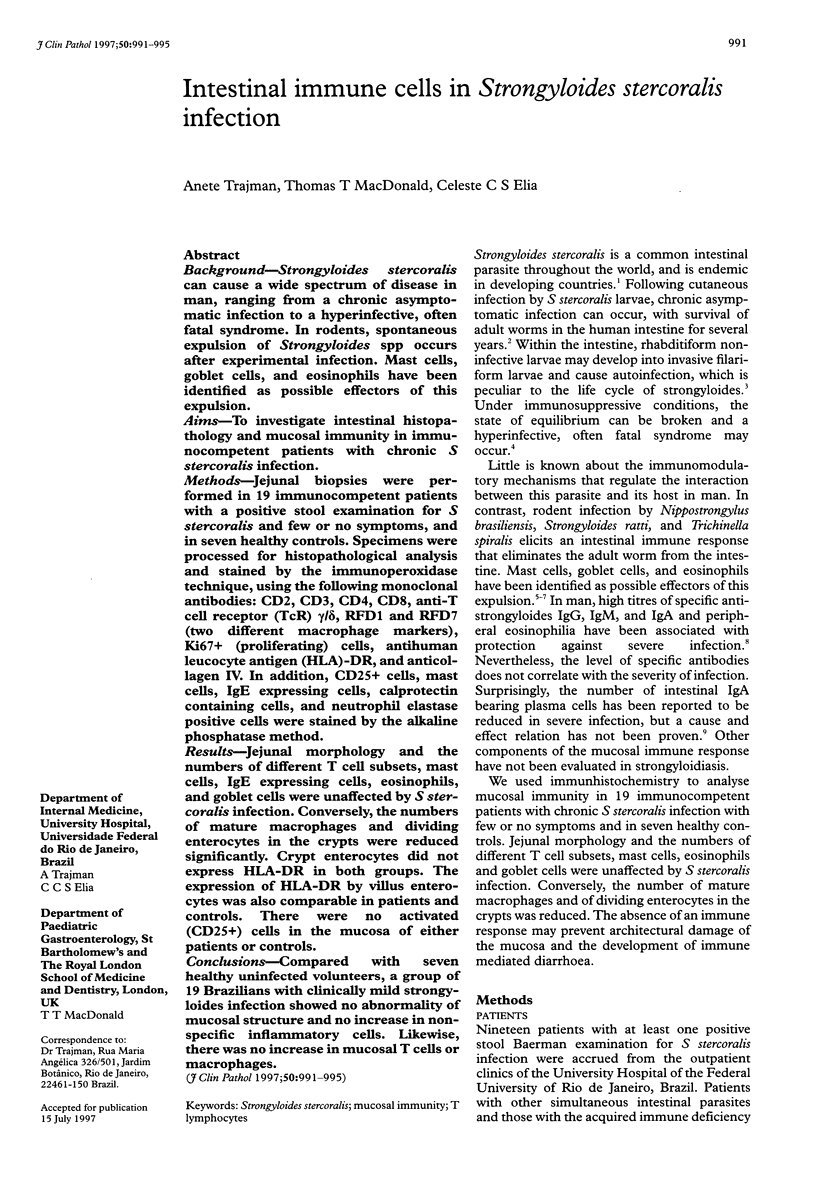
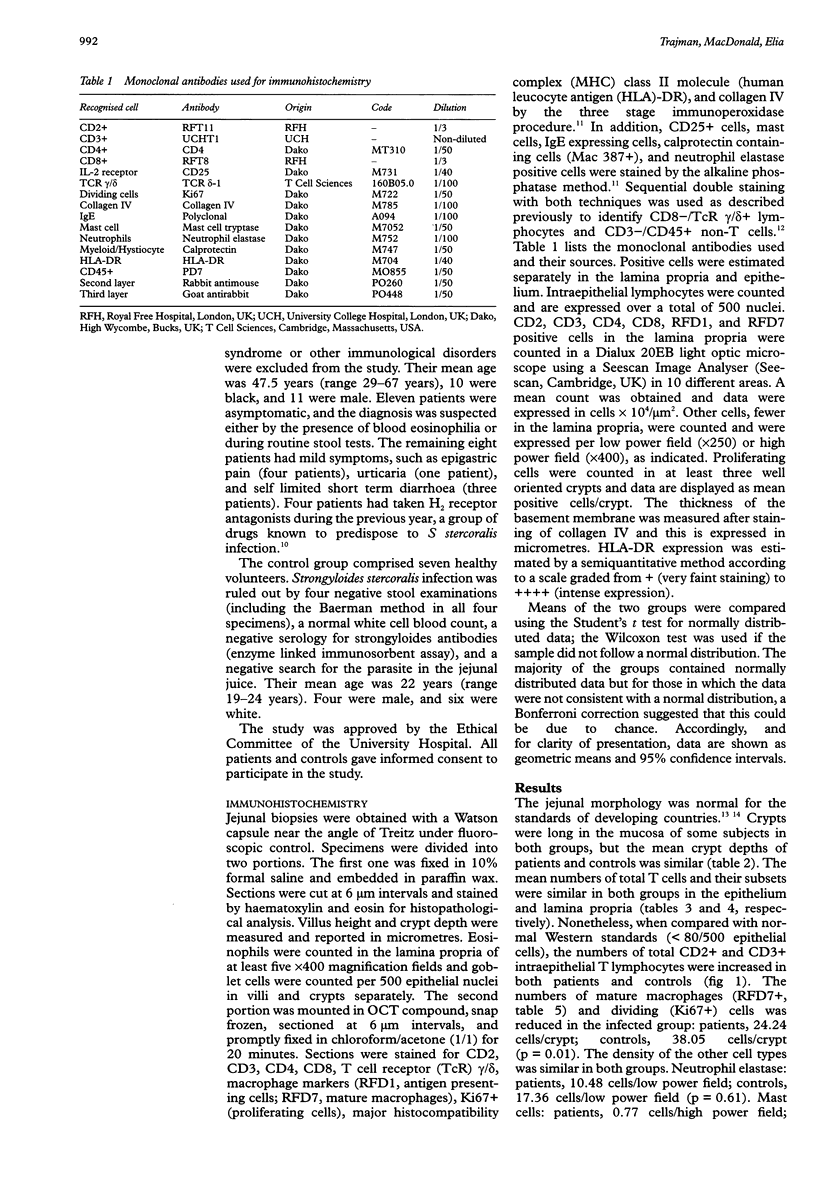
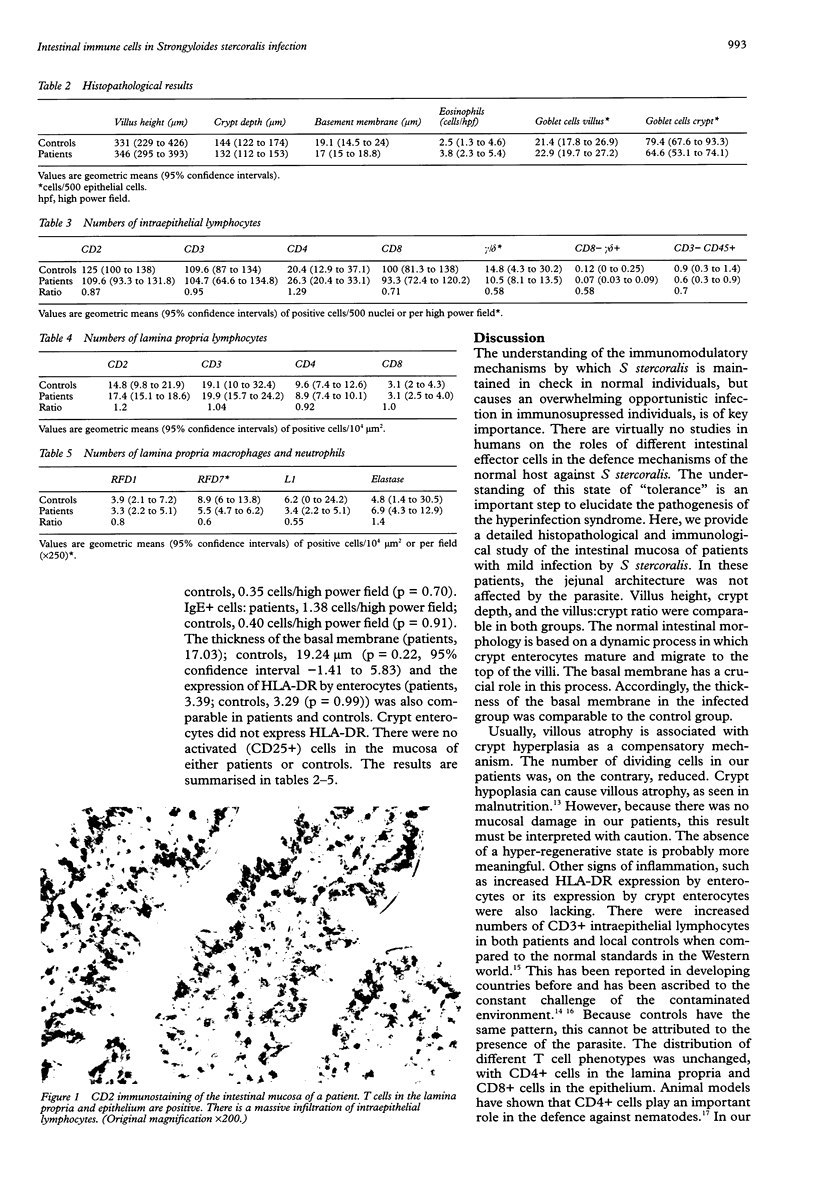
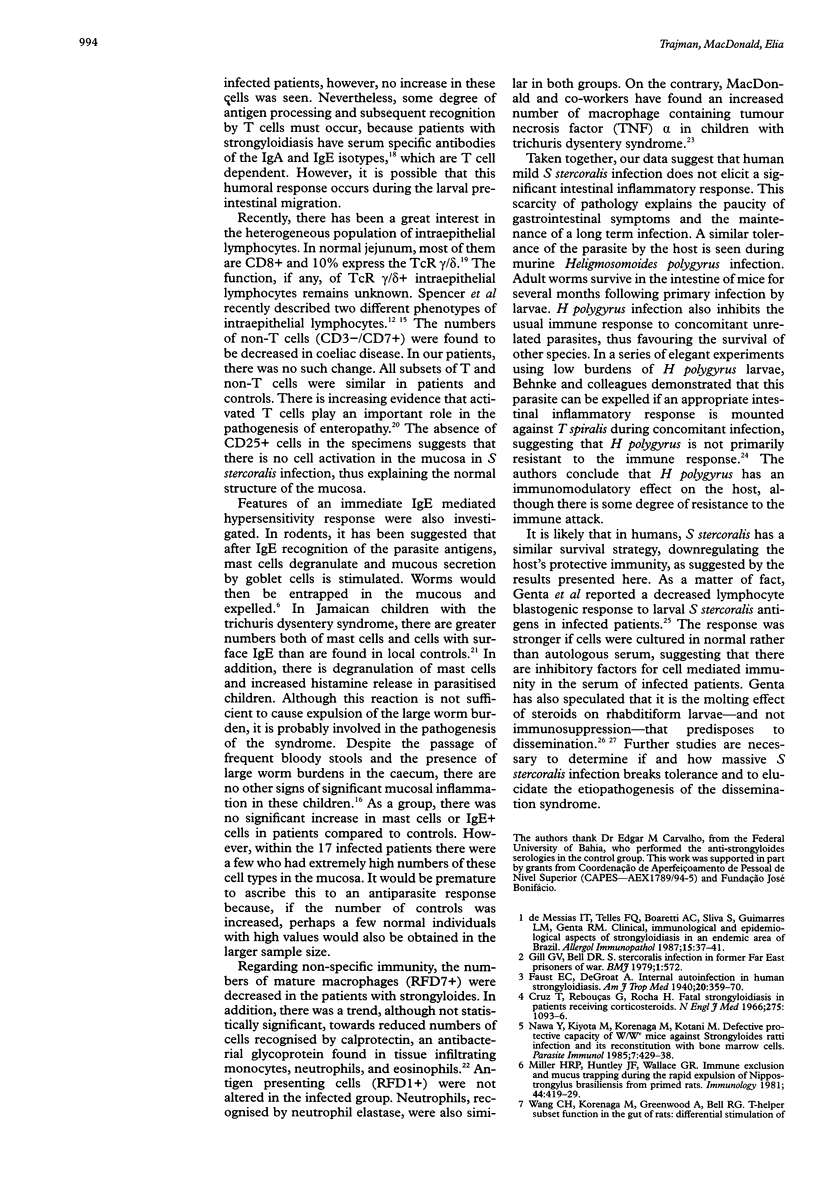
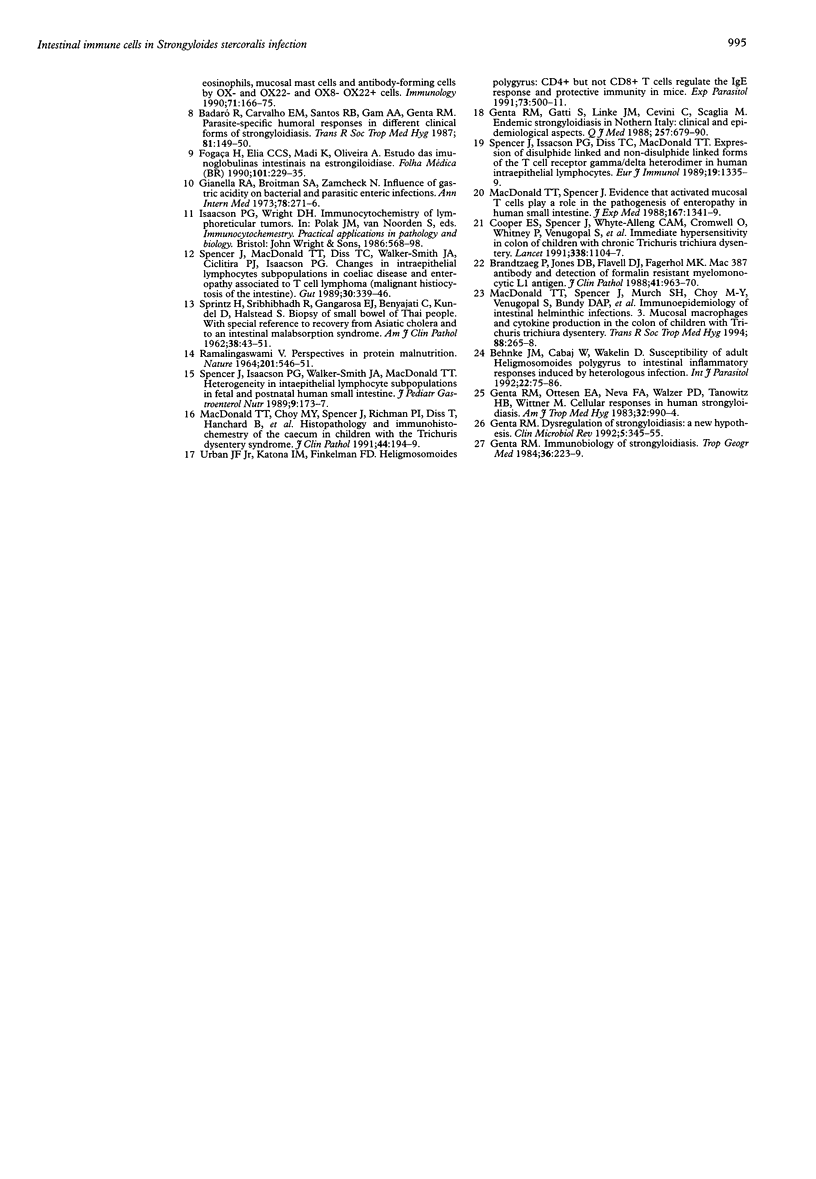
Images in this article
Selected References
These references are in PubMed. This may not be the complete list of references from this article.
- Badaró R., Carvalho E. M., Santos R. B., Gam A. A., Genta R. M. Parasite-specific humoral responses in different clinical forms of strongyloidiasis. Trans R Soc Trop Med Hyg. 1987;81(1):149–150. doi: 10.1016/0035-9203(87)90309-9. [DOI] [PubMed] [Google Scholar]
- Behnke J. M., Cabaj W., Wakelin D. Susceptibility of adult Heligmosomoides polygyrus to intestinal inflammatory responses induced by heterologous infection. Int J Parasitol. 1992 Feb;22(1):75–86. doi: 10.1016/0020-7519(92)90082-v. [DOI] [PubMed] [Google Scholar]
- Brandtzaeg P., Jones D. B., Flavell D. J., Fagerhol M. K. Mac 387 antibody and detection of formalin resistant myelomonocytic L1 antigen. J Clin Pathol. 1988 Sep;41(9):963–970. doi: 10.1136/jcp.41.9.963. [DOI] [PMC free article] [PubMed] [Google Scholar]
- Cooper E. S., Spencer J., Whyte-Alleng C. A., Cromwell O., Whitney P., Venugopal S., Bundy D. A., Haynes B., MacDonald T. T. Immediate hypersensitivity in colon of children with chronic Trichuris trichiura dysentery. Lancet. 1991 Nov 2;338(8775):1104–1107. doi: 10.1016/0140-6736(91)91964-v. [DOI] [PubMed] [Google Scholar]
- Cruz T., Reboucas G., Rocha H. Fatal strongyloidiasis in patients receiving corticosteroids. N Engl J Med. 1966 Nov 17;275(20):1093–1096. doi: 10.1056/NEJM196611172752003. [DOI] [PubMed] [Google Scholar]
- Genta R. M. Dysregulation of strongyloidiasis: a new hypothesis. Clin Microbiol Rev. 1992 Oct;5(4):345–355. doi: 10.1128/cmr.5.4.345. [DOI] [PMC free article] [PubMed] [Google Scholar]
- Genta R. M., Gatti S., Linke M. J., Cevini C., Scaglia M. Endemic strongyloidiasis in northern Italy: clinical and immunological aspects. Q J Med. 1988 Sep;68(257):679–690. [PubMed] [Google Scholar]
- Genta R. M. Immunobiology of strongyloidiasis. Trop Geogr Med. 1984 Sep;36(3):223–229. [PubMed] [Google Scholar]
- Genta R. M., Ottesen E. A., Neva F. A., Walzer P. D., Tanowitz H. B., Wittner M. Cellular responses in human strongyloidiasis. Am J Trop Med Hyg. 1983 Sep;32(5):990–994. doi: 10.4269/ajtmh.1983.32.990. [DOI] [PubMed] [Google Scholar]
- Giannella R. A., Broitman S. A., Zamcheck N. Influence of gastric acidity on bacterial and parasitic enteric infections. A perspective. Ann Intern Med. 1973 Feb;78(2):271–276. doi: 10.7326/0003-4819-78-2-271. [DOI] [PubMed] [Google Scholar]
- Gill G. V., Bell D. R. Strongyloides stercoralis infection in former Far East prisoners of war. Br Med J. 1979 Sep 8;2(6190):572–574. doi: 10.1136/bmj.2.6190.572. [DOI] [PMC free article] [PubMed] [Google Scholar]
- MacDonald T. T., Choy M. Y., Spencer J., Richman P. I., Diss T., Hanchard B., Venugopal S., Bundy D. A., Cooper E. S. Histopathology and immunohistochemistry of the caecum in children with the Trichuris dysentery syndrome. J Clin Pathol. 1991 Mar;44(3):194–199. doi: 10.1136/jcp.44.3.194. [DOI] [PMC free article] [PubMed] [Google Scholar]
- MacDonald T. T., Spencer J. Evidence that activated mucosal T cells play a role in the pathogenesis of enteropathy in human small intestine. J Exp Med. 1988 Apr 1;167(4):1341–1349. doi: 10.1084/jem.167.4.1341. [DOI] [PMC free article] [PubMed] [Google Scholar]
- MacDonald T. T., Spencer J., Murch S. H., Choy M. Y., Venugopal S., Bundy D. A., Cooper E. S. Immunoepidemiology of intestinal helminthic infections. 3. Mucosal macrophages and cytokine production in the colon of children with Trichuris trichiura dysentery. Trans R Soc Trop Med Hyg. 1994 May-Jun;88(3):265–268. doi: 10.1016/0035-9203(94)90072-8. [DOI] [PubMed] [Google Scholar]
- Miller H. R., Huntley J. F., Wallace G. R. Immune exclusion and mucus trapping during the rapid expulsion of Nippostrongylus brasiliensis from primed rats. Immunology. 1981 Oct;44(2):419–429. [PMC free article] [PubMed] [Google Scholar]
- Nawa Y., Kiyota M., Korenaga M., Kotani M. Defective protective capacity of W/Wv mice against Strongyloides ratti infection and its reconstitution with bone marrow cells. Parasite Immunol. 1985 Jul;7(4):429–438. doi: 10.1111/j.1365-3024.1985.tb00088.x. [DOI] [PubMed] [Google Scholar]
- RAMALINGASWAMI V. PERSPECTIVES IN PROTEIN MALNUTRITION. Nature. 1964 Feb 8;201:546–551. doi: 10.1038/201546a0. [DOI] [PubMed] [Google Scholar]
- SPRINZ H., SRIBHIBHADH R., GANGAROSA E. J., BENYAJATI C., KUNDEL D., HALSTEAD S. Biopsy of small bowel of Thai people. With special reference to recovery from Asiatic cholera and to an intestinal malabsorption syndrome. Am J Clin Pathol. 1962 Jul;38:43–51. doi: 10.1093/ajcp/38.1.43. [DOI] [PubMed] [Google Scholar]
- Spencer J., Isaacson P. G., Diss T. C., MacDonald T. T. Expression of disulfide-linked and non-disulfide-linked forms of the T cell receptor gamma/delta heterodimer in human intestinal intraepithelial lymphocytes. Eur J Immunol. 1989 Jul;19(7):1335–1338. doi: 10.1002/eji.1830190728. [DOI] [PubMed] [Google Scholar]
- Spencer J., Isaacson P. G., Walker-Smith J. A., MacDonald T. T. Heterogeneity in intraepithelial lymphocyte subpopulations in fetal and postnatal human small intestine. J Pediatr Gastroenterol Nutr. 1989 Aug;9(2):173–177. doi: 10.1097/00005176-198908000-00007. [DOI] [PubMed] [Google Scholar]
- Spencer J., MacDonald T. T., Diss T. C., Walker-Smith J. A., Ciclitira P. J., Isaacson P. G. Changes in intraepithelial lymphocyte subpopulations in coeliac disease and enteropathy associated T cell lymphoma (malignant histiocytosis of the intestine). Gut. 1989 Mar;30(3):339–346. doi: 10.1136/gut.30.3.339. [DOI] [PMC free article] [PubMed] [Google Scholar]
- Urban J. F., Jr, Katona I. M., Finkelman F. D. Heligmosomoides polygyrus: CD4+ but not CD8+ T cells regulate the IgE response and protective immunity in mice. Exp Parasitol. 1991 Nov;73(4):500–511. doi: 10.1016/0014-4894(91)90074-7. [DOI] [PubMed] [Google Scholar]
- Wang C. H., Korenaga M., Greenwood A., Bell R. G. T-helper subset function in the gut of rats: differential stimulation of eosinophils, mucosal mast cells and antibody-forming cells by OX8- OX22- and OX8- OX22+ cells. Immunology. 1990 Oct;71(2):166–175. [PMC free article] [PubMed] [Google Scholar]
- de Messias I. T., Telles F. Q., Boaretti A. C., Sliva S., Guimarres L. M., Genta R. M. Clinical, immunological and epidemiological aspects of strongyloidiasis in an endemic area of Brazil. Allergol Immunopathol (Madr) 1987 Jan-Feb;15(1):37–41. [PubMed] [Google Scholar]



